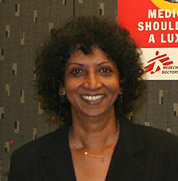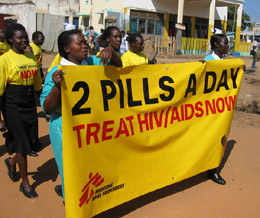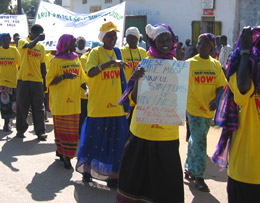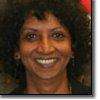Janthimala Price, a midwife from Australia, spent 20 months at the Arua Hospital AIDS Program in rural northwestern Uganda. The program was set up in July 2002 by the Arua Regional Referral Hospital Doctors Without Borders/Médecins Sans Frontières (MSF). It provides treatment to thousands of people living with HIV/AIDS, including free antiretroviral (ARV) therapy for nearly 1,300. Since the beginning of the AIDS pandemic, more than a million people have died of HIV/AIDS in Uganda, and the World Health Organization (WHO) and UNAIDS estimate that more than 530,000 Ugandans are living with HIV/AIDS today. Unfortunately, only 20,000, or 18 percent, of the nearly 110,000 people who are in urgent clinical need of ARVs receive this treatment.
|

|
What has MSF learned from opening the Arua Hospital AIDS Program?
Arua is really a resource-limited area, and the program showed that it’s possible to treat HIV/AIDS in poor rural areas. We started with seven patients in July 2002. Nobody believed that we could be treating more than 1,300 patients with ARVs by the end of 2004. Since July 2003, we have increased the number of patients admitted from 20 to 80 per month.
A significant element of the success of the program has been the simplification of treatment and the monitoring of patients. We are using a “3-in-1” fixed-dose combination medicine taken only twice a day. The ARVs have a very rapid effect on our patients. They gain weight rapidly and become less vulnerable to opportunistic diseases. I remember one patient who told me: “Look at me, I was not meant to die. Because there is a drug, I’m better now. I was weak; I was dying. But now I can work and support my family.”

© MSF |
What role do people living with HIV/AIDS play in the program’s success?
If it weren’t for the people living with HIV/AIDS and the self-support groups, we would not see people lining up in front of the clinic like they do. Our patients are living proof, living examples. Through self-support groups, they send out a powerful message of hope. They are the best voice there is to educate the general public especially in dealing with the stigma surrounding HIV/AIDS, which is still very strong in Uganda. They don’t limit their actions to our clinic, either, but have reached out to more isolated villages in an increasingly structured manner. This education builds awareness in general but also increases testing.
One very successful group is the prevention of mother-to-child transmission (PMTCT) self support group. They started with three patients in August 2003 and now have more than 50 mothers. Pregnant women share their experiences, provide counseling to new members and also put together testimonies – often using drama. They have even organized income-generating programs such as basket weaving or pottery to sustain their families.
I can tell you: these women are not afraid to speak out and to disclose their status. As a midwife, I feel a special connection to the group. I got involved with them very early on and it has been a great joy to see what they have achieved. Last July, I was moved when one patient said to me: “Look, if it wasn’t for the AIDS clinic, my child would not be like this. I wanted you to see: he’s walking and he’s well. And he’s HIV negative.” I believe it was the one of the first PMTCT groups in Uganda. We also have men’s group but the percentage of men on treatment is very low compared to women. We need to do better to get men to test more.

© MSF |
What are the next steps?
MSF will decentralize medical services from Arua to the city of Koboko, 30 miles to the north on the border with DRC and Sudan. It is a relatively dynamic city at the center of a district of about 400,000 people. We chose it because many of our patients live there, and transportation can be a hindrance to adherence. Many patients cannot afford to pay for their transport and thus have to walk several hours from Koboko. This is why we wanted to be as close as possible to our patients. We learned that support groups are already in place. The ministry of health’s hospital is very close to the market, which attracts people from the surrounding areas twice a week. This will be very convenient for outreach.
Overseeing those patients from Koboko who are already registered in Arua will be the first step. As the treatment program builds up more and more capacity, we will provide technical guidance to the ministry of health on clinical diagnosis of AIDS symptoms, medication protocols and compliance training for patients. The adherence program will rely heavily on patients who are already on ARVs to support new patients. As always we work in collaboration with local authorities in the view of handing over the program in the near future. This will be the ultimate goal. Already in 2004, we have substantially increased the number of Ministry of Health staff in the HIV clinic in Arua, rather than bringing in new MSF staff.
But throughout the country, too many Ugandans are still in urgent need of treatment and care. Their needs are very far from being met, and the government needs to commit to treating people. There is still a long way to go.




